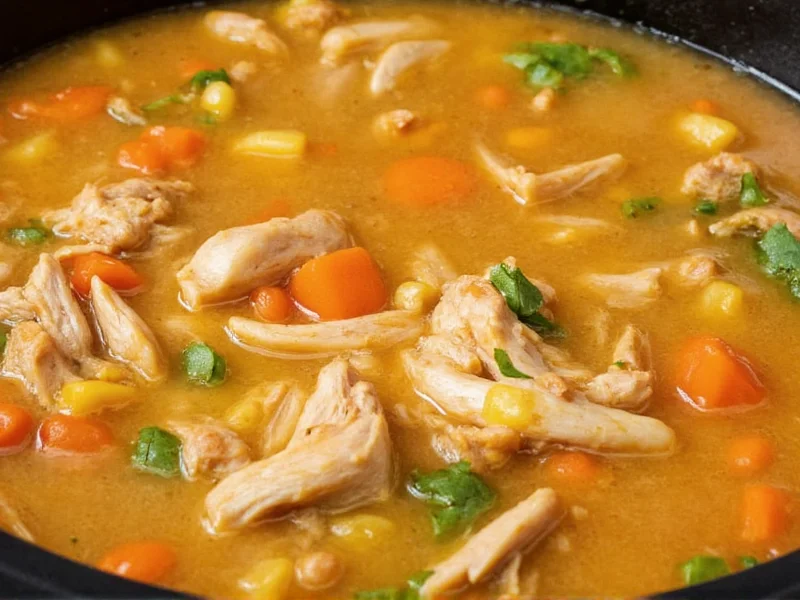Making chicken vegetable soup in a slow cooker transforms simple ingredients into a nourishing meal with minimal effort. The slow cooking process allows flavors to meld beautifully while keeping the chicken moist and vegetables at their ideal texture. Unlike stovetop methods that require constant monitoring, the slow cooker handles the work while you go about your day.
Why Slow Cooker Chicken Vegetable Soup Works Best
The magic of slow cooking lies in its gentle, consistent heat. Chicken thighs stay incredibly tender without drying out, while vegetables maintain their shape yet become perfectly soft. The extended cooking time extracts maximum flavor from bones and vegetables, creating a broth that's rich and complex without requiring hours of attention. This method is ideal for meal prep, as the soup tastes even better the next day and freezes well for future meals.
Essential Ingredients for Perfect Results
Quality ingredients make all the difference in this easy chicken vegetable soup slow cooker recipe. While you can customize vegetables based on seasonality, these core components create the best foundation:
| Ingredient | Quantity | Preparation Notes |
|---|---|---|
| Chicken thighs (bone-in, skin-on) | 1.5 lbs | Provides richer flavor than breasts; remove bones after cooking |
| Low-sodium chicken broth | 6 cups | Use homemade or quality store-bought for best results |
| Carrots | 4 medium | Chopped into 1/2-inch pieces for even cooking |
| Celery | 3 stalks | Chopped; don't discard leaves for garnish |
| Yellow onion | 1 large | Diced; yellow provides best flavor balance |
| Garlic | 2 cloves | Minced; add at beginning for milder flavor |
| Potatoes | 1 cup | Diced Yukon Gold hold shape well during cooking |
| Green beans | 1 cup | Add in last hour to maintain texture |
| Dried thyme | 1 tsp | Or 1 tbsp fresh thyme leaves |
| Bay leaf | 1 | Remove before serving |
Step-by-Step Slow Cooker Method
Follow these straightforward steps for the best slow cooker chicken and vegetable soup:
- Prepare ingredients: Chop all vegetables to uniform sizes for even cooking. Pat chicken dry and season with salt and pepper.
- Layer ingredients: Place chicken at bottom of slow cooker, then add onions, carrots, celery, potatoes, garlic, thyme, and bay leaf. Pour broth over everything.
- Cook: Cover and cook on LOW for 6-8 hours or HIGH for 3-4 hours. Avoid opening the lid frequently as this adds significant cooking time.
- Finish vegetables: During the last 60 minutes of cooking, add delicate vegetables like green beans, peas, or zucchini.
- Shred chicken: Remove chicken, discard bones and skin, then shred meat with two forks. Return to pot.
- Final seasoning: Stir in fresh parsley, adjust salt and pepper, and add a splash of lemon juice to brighten flavors.
Avoiding Common Slow Cooker Mistakes
Even the best healthy chicken vegetable soup crockpot recipe can go wrong without proper technique. Watch for these pitfalls:
- Overfilling the slow cooker: Never fill beyond 2/3 capacity to allow for proper heat circulation and prevent spills.
- Adding delicate vegetables too early: Leafy greens, peas, and fresh herbs should go in during the last 30-60 minutes.
- Skipping the sear: For deeper flavor, quickly sear chicken in a hot pan before adding to slow cooker (optional but recommended).
- Overcooking potatoes: Waxy potatoes like Yukon Gold hold shape better than russets in long cooking times.
- Not adjusting seasoning at the end: Flavors concentrate during slow cooking, so always taste and adjust salt before serving.
Customizing Your Soup
This versatile base recipe adapts beautifully to different preferences and dietary needs:
- Gluten-free version: Ensure your broth is certified gluten-free and skip any flour-based thickeners.
- Creamy variation: Stir in 1/2 cup coconut milk or heavy cream during the last 30 minutes for a richer texture.
- Extra protein: Add 1 cup cooked white beans or lentils during the last hour of cooking.
- Low-carb option: Replace potatoes with turnips or radishes and increase leafy greens.
- Spicy kick: Add 1/4 tsp red pepper flakes with the dried herbs for subtle heat.
Storage and Reheating Tips
One of the best features of this freezer-friendly chicken vegetable soup is how well it stores:
- Refrigeration: Store in airtight containers for up to 5 days. Flavors improve overnight as ingredients meld.
- Freezing: Portion into freezer bags or containers, removing excess air. Freeze for up to 3 months.
- Reheating: Thaw overnight in refrigerator, then reheat gently on stove over medium-low heat. Add splashes of broth if needed to restore consistency.
- Revitalizing leftovers: Stir in fresh herbs, a squeeze of lemon, or additional vegetables when reheating to refresh flavors.
Nutritional Benefits
This nutrient-dense soup delivers balanced nourishment in every bowl. A typical serving (about 1.5 cups) contains approximately:
- 320 calories
- 25g protein
- 18g carbohydrates
- 15g fat (mostly unsaturated from chicken skin)
- High in vitamins A, C, and K from vegetables
- Excellent source of potassium and fiber
The slow cooking process preserves nutrients better than boiling, while the combination of lean protein and fiber-rich vegetables creates a satisfying meal that supports immune health and digestion.











 浙公网安备
33010002000092号
浙公网安备
33010002000092号 浙B2-20120091-4
浙B2-20120091-4